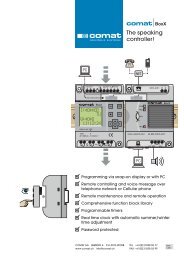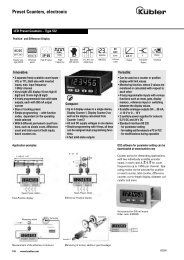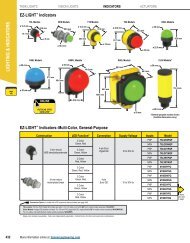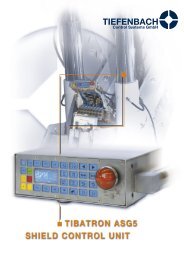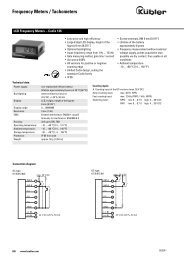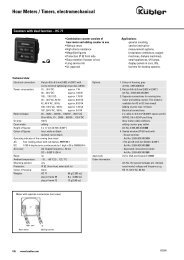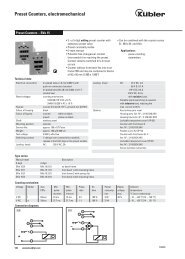Socket relays.pdf
Socket relays.pdf
Socket relays.pdf
You also want an ePaper? Increase the reach of your titles
YUMPU automatically turns print PDFs into web optimized ePapers that Google loves.
Coil accessories<br />
General information<br />
MRC – QRC<br />
Protection against transients<br />
When the coil is disconnected from an electromagnet,<br />
peaks of inverse voltage appear<br />
at the terminals which can reach very high<br />
values. These pulses can be transmitted<br />
down the line associated with the coil and<br />
could possibly affect other components.<br />
In the case of a realy being operated by such<br />
devices as transistors, triacs, etc; it may be<br />
necessary to protect against transients.<br />
Transients carried in the line<br />
High voltage surges can be carried in the<br />
supply line to the relay coil. These may<br />
appear in the form of peaks or bursts and are<br />
generated by the connection and disconnection<br />
of electric motors, transformers, capacitors<br />
etc.<br />
Normally a relay is unaffected by these<br />
pulses, but if a diode is connected in association<br />
with the coil, it must be capable of withstanding<br />
an inverse voltage higher than those<br />
of the incoming peaks.<br />
Protection circuits<br />
A protection circuit must efficiently cope with<br />
pulses generated by the coil as well as incoming<br />
line surges (surges U 1,2/50µs.)<br />
Releco <strong>relays</strong> are available with integrated<br />
protection circuits or with modules plugged<br />
into sockets S3-MP or S3-MS.<br />
X LED indication with rectifier.<br />
For DC and AC <strong>relays</strong> up to 250 V<br />
Surges of 1000 V up to 24 V<br />
Surges of 2000 V from 25 to 60 V<br />
Surges of 4000 V from 61 to 250 V<br />
Note: LED connected, in series with the coil @<br />
220 VDC in QRC types.<br />
D Free-wheeling diode.<br />
DX Free-wheeling diode + LED<br />
Dampens transients caused by the relay coil<br />
on de-energisation.<br />
Surges of 2000 V up to 60 VDC<br />
Surges of 4000 V from 61 to 250 VDC (*)<br />
F Polarity + free wheeling diode.<br />
FX Polarity + free wheeling diode + LED<br />
A diode in series with the coil protects the<br />
relay from reverse connection.<br />
Surges of 1000 V up to 60 VDC<br />
Surges of 4000 V from 61 to 250 VDC (*)<br />
B Bridge rectifier incorporated<br />
BX Bridge rectifier + LED indication<br />
Allows the relay to operate in both AC or DC<br />
without any polarity inconvience. Available<br />
only in voltages up to 60 V.<br />
Surges of 1000 V<br />
R Resistor and capacitor.<br />
Suppressor for AC coils. Surges of 2000 V.<br />
Available only in MRC types.<br />
(*) Surges of 2000 V in QRC types.<br />
IRC<br />
LED and protection circuit connected to<br />
coil.<br />
X<br />
X<br />
FX<br />
BX<br />
R<br />
LED with no polarity, (standard)<br />
Coils ≤ 12 V CC y CA<br />
LED rectifier bridge in parallel<br />
LED with no polarity, (standard)<br />
Coils ≥ 24 V … CC y CA<br />
LED rectifier bridge in series<br />
LED with polarity A1+ (option)<br />
Every DC coil voltage<br />
Polarity and Free-wheeling diodes<br />
LED with no polarity, (option)<br />
Only 24 V and 48 V ADC coils<br />
Rectifier bridge for AC/DC <strong>relays</strong><br />
LED not available (option)<br />
RC protection against pulses on AC<br />
Protection against pulses<br />
When a relay coil is disconnected, reverse<br />
voltage peaks may arise and reach very high<br />
values. Said peaks can transmit to the coil<br />
associated line and other <strong>relays</strong> or semiconductors<br />
can be affected.<br />
If triac, transistor, etc. controls a relay, appropiate<br />
steps must be taken to avoid or decrease<br />
peaks down to a non risky level.<br />
Both Polarity and Free-wheeling diodes (FX),<br />
must protect coils, to avoid malfunctions provided<br />
DC <strong>relays</strong> in battery are installed.<br />
Making or breaking engines, transformers or<br />
contactors in an industrial environmental, may<br />
generate high voltage pulses, either isolated<br />
or burst, through the main line.<br />
The voltage level of those pulse may be high<br />
enough to affect the isolation of the coil.<br />
LED consumption: 1mA<br />
Increases release time approx. 4 times<br />
>12V<br />
Increase release time approx. 4 times<br />
Increases release time approx. 3 times<br />
6 | 0410 This issue replaces all previous issues. Availability, errors and specifications subject to change without notice.



